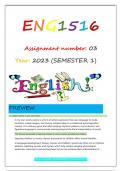ENG1516
Assignment number: 03
Year: 2023 (SEMESTER 1)
PREVIEW:
1.1. Define “poetry” in your own words.
In my own words, poetry is a form of artistic expression that uses language to evoke
emotions, create imagery, and convey complex ideas in a condensed and imaginative
manner. It is a literary genre that often employs rhythmic patterns, sound devices, and
figurative language to communicate meaning beyond the literal interpretation of words.
1.2. Discuss two benefits of exposing children to nursery rhymes and poems for children.
Exposing children to nursery rhymes and poems for children offers several benefits:
a) Language Development: Nursery rhymes and children's poems are often rich in rhythmic
patterns, repetitive sounds, and rhymes, which help children develop phonological
awareness. Listening to and reciting these rhymes can enhance their understanding of ….
LOLA JACOBS ASSIGNMENTS 0618151315
, ASSIGNMENT 03: Promoting a Reading Culture in your Classroom
This assignment is based on Units 5 and 6 in Tutorial Letter 501. Work through these two
units before you attempt the assignment. Answer the questions below in full sentences.
QUESTION 1
1.1. Define “poetry” in your own words.
(2)
In my own words, poetry is a form of artistic expression that uses language
to evoke emotions, create imagery, and convey complex ideas in a
condensed and imaginative manner. It is a literary genre that often employs
rhythmic patterns, sound devices, and figurative language to communicate
meaning beyond the literal interpretation of words.
1.2. Discuss two benefits of exposing children to nursery rhymes and poems for children.
Exposing children to nursery rhymes and poems for children offers several
benefits:
a) Language Development: Nursery rhymes and children's poems are often
rich in rhythmic patterns, repetitive sounds, and rhymes, which help children
develop phonological awareness. Listening to and reciting these rhymes can
enhance their understanding of syllables, phonetics, and the overall
structure of language. This exposure lays a foundation for vocabulary
expansion and improves their pronunciation, articulation, and overall
fluency in speech.
b) Cognitive and Emotional Development: Poetry engages children's
imagination and encourages creative thinking. Through the vivid imagery
and imaginative language used in poems, children can explore different
concepts, emotions, and perspectives. This exposure fosters their cognitive
development by promoting critical thinking, problem-solving, and the
ability to interpret and analyze abstract ideas. Additionally, poems often
express emotions, and when children connect with these emotions, it can
help them develop empathy, emotional intelligence, and a greater
understanding of their own feelings.
LOLA JACOBS ASSIGNMENTS 0618151315




